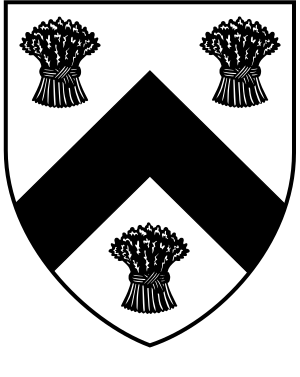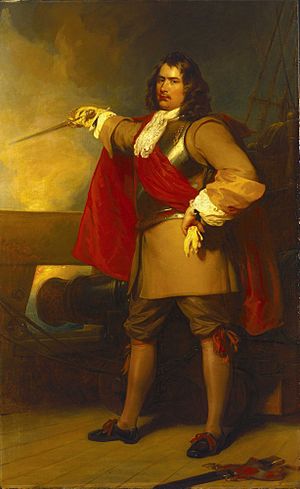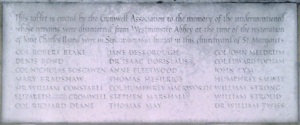Robert Blake (admiral) facts for kids
Quick facts for kids
Robert Blake
|
|
|---|---|
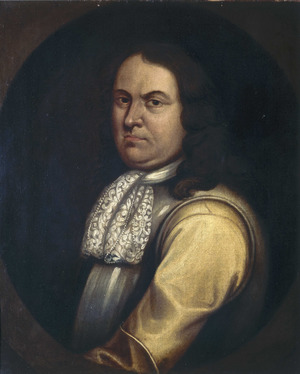 |
|
| Lord Warden of the Cinque Ports | |
| In office 1656–1657 |
|
| Preceded by | Thomas Kelsey |
| Succeeded by | Lord Winchilsea |
| Personal details | |
| Born | 27 September 1598 Bridgwater, England |
| Died | 7 August 1657 (aged 58) Off Plymouth, English Channel |
| Resting place | Westminster Abbey (initially); St Margaret's (now) |
| Relations | Joseph Blake (nephew) |
| Nickname | "Father of the Royal Navy" |
| Military service | |
| Allegiance | |
| Branch/service | Commonwealth Navy |
| Years of service | 1649–1657 |
| Rank | General at Sea |
| Commands | Mediterranean Fleet |
| Battles/wars | English Civil War First Anglo-Dutch War Anglo-Spanish War |
General at Sea Robert Blake (born September 27, 1598 – died August 17, 1657) was an important English naval officer. He was known as the "Father of the Royal Navy" because he helped make England's navy very strong. This strength continued for many years, even into the 1900s.
Blake's amazing achievements were sometimes forgotten after the king returned to power. But many people believe his successes were as great as, or even better than, those of famous admirals like Nelson.
Contents
Early Life and Education
Robert Blake's family had lived in Somerset, England, for a long time. His grandfather, also named Robert, was a merchant who traded with Spain. He became a respected leader in the town of Bridgwater.
Robert Blake was the first of thirteen children. He went to Bridgwater Grammar School and then to Wadham College at Oxford University. He wanted to become a scholar. However, he didn't get a special scholarship, possibly because of his political and religious beliefs. Also, the head of the college didn't like short people, and Blake was only five feet, six inches tall.
After leaving university in 1625, Blake likely worked in trade. He may have lived in the Netherlands for several years. He returned to Bridgwater around 1638 after his mother passed away.
Blake's Start in Politics
In 1640, Robert Blake was chosen to represent his hometown, Bridgwater, in the English Parliament. When the English Civil War began, Blake joined the side of the Parliamentarians. This was surprising because he didn't have much experience in military or naval matters.
Later, after being injured in a battle at sea, he returned to Parliament. He represented Bridgwater and Taunton in different Parliaments before going back to sea.
Blake's Land Battles
Blake started his military career as a captain in the New Model Army. He quickly showed his bravery and skill. He became a lieutenant colonel after fighting well at the Siege of Bristol in 1643.
He was promoted to colonel after bravely defending Lyme Regis in 1644. His most famous moment on land was during the Siege of Taunton in 1645. He famously said he would rather eat his boots than surrender. He successfully held Taunton, which made him famous across England. He also won the Siege of Dunster later that year.
In 1649, Robert Blake was given the important role of general at sea. This rank was like being both an admiral and a navy leader. He was never called "admiral" because that rank wasn't used in the Parliamentarian navy.
Blake is often called the "Father of the Royal Navy." He helped build the navy from a few ships to over a hundred. He was also the first to keep a fleet at sea during the winter months.
Blake created the navy's first set of rules, called The Laws of War and Ordinances of the Sea. These rules listed many offenses and their punishments, often death. He also helped create the first naval courts-martial in the English navy.
Blake developed new ways to block enemy ports and land troops. His Sailing Instructions and Fighting Instructions changed how naval battles were fought. These instructions, written in 1653, were the basis for English naval tactics in the Age of Sail. Blake's Fighting Instructions were the first to use the single line ahead formation in battle. He was also the first to successfully attack enemy forts from the sea, even when they were firing back.
In 1656, the year before he died, Blake was appointed Lord Warden of the Cinque Ports. This was an important role in charge of five historic port towns.
Battles of the English Civil War
In 1649, Prince Rupert of the Rhine tried to stop the Parliamentarians from taking Ireland. Blake blockaded Rupert's fleet in Kinsale, Ireland. This allowed Oliver Cromwell to land his army. After a storm, Rupert escaped to Lisbon, Portugal.
Blake followed Rupert to Lisbon in 1650. He tried to convince the Portuguese king to expel Rupert. The king supported Rupert, so Blake went to war with Portugal. Blake captured seven Portuguese ships and sank their vice-admiral's ship. He then fought Rupert's ships near Málaga, capturing one. This victory secured Parliament's control of the sea. Many European countries then recognized the Parliamentarian government.
Parliament thanked Blake by giving him 1,000 pounds. In 1651, Blake captured the Isles of Scilly, which was the last place held by the Royalist navy. For this, he was again thanked by Parliament and became a member of the Council of State.
Because the navy controlled the sea, it could supply Cromwell's army as it marched into Scotland. By the end of 1652, England's colonies in the Americas were also secured.
First Anglo-Dutch War
Blake's next big challenge was the First Anglo-Dutch War. The war began with a small fight between the Dutch fleet and Blake's ships in May 1652. The full war started in June with England attacking Dutch trade ships.
In October 1652, the Dutch Vice-Admiral tried to attack Blake. But Blake attacked first in the Battle of the Kentish Knock, defeating the Dutch. The English government thought the war was over and sent some ships away. This left Blake with only 42 warships.
In December 1652, Blake was attacked by 88 Dutch ships under Admiral Tromp in the Battle of Dungeness. Blake was defeated, and the Dutch took control of the English Channel.
After this defeat, Blake demanded major changes to the navy. New rules were made to give admirals more authority over their captains. Blake then sailed with about 75 ships to disrupt Channel shipping. He fought Tromp again in the Battle of Portland in February 1653. Tromp managed to escape with his convoy.
At the Battle of the Gabbard in June 1653, Blake joined other English generals and decisively defeated the Dutch fleet. They sank or captured 17 Dutch ships without losing any. This victory gave England control of the North Sea. The Dutch fleet was then blocked in their ports until the Battle of Scheveningen, where Tromp was killed.
Battles in the Mediterranean
After making peace with the Dutch, Blake sailed to the Mediterranean in October 1654. He commanded 24 warships and successfully stopped the Duke of Guise from conquering Naples.
Facing the Bey of Tunis
In April 1655, Blake was sent to the Mediterranean again. His mission was to get payment from pirate states that had been attacking English ships. The ruler of Tunis refused to pay. Blake, with 15 ships, then destroyed two shore forts and nine Algerian ships in Porto Farina. This was the first time shore forts were taken out without landing soldiers.
Anglo-Spanish War

In February 1656, England and Spain went to war. Blake blockaded Cádiz, a Spanish port. During this blockade, one of his captains destroyed most of the Spanish treasure fleet in the Battle of Cádiz. A galleon full of treasure was captured, costing Spain a huge amount of money. Blake kept the blockade going all winter, which was a first for the English fleet.
On April 20, 1657, Blake completely destroyed another Spanish fleet in the Battle of Santa Cruz de Tenerife. This port was very well protected and thought to be impossible to attack from the sea. Blake lost only one ship. Even though the silver treasure had already been unloaded, Blake's victory delayed its arrival in Spain. This battle earned the new English Navy great respect across Europe. Cromwell rewarded Blake with an expensive diamond ring.
This action also earned Blake respect from Lord Nelson 140 years later. Nelson, who lost his arm in a later attack on Santa Cruz, wrote that he didn't consider himself equal to Blake. Nelson ranked Robert Blake as one of the greatest naval generals ever.
Death and Burial
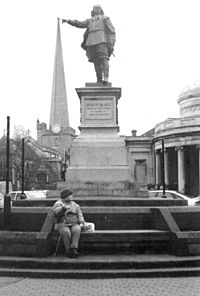
After cruising off Cádiz for a while, Blake began his journey home. Sadly, he died from old wounds as his ship came into sight of Plymouth.
He was given a full state funeral and was buried in Westminster Abbey. Oliver Cromwell and other important leaders were there. However, after the king returned to power in 1660, Blake's body was dug up in 1661. King Charles II ordered his body to be moved to a common grave in St Margaret's churchyard, next to the Abbey.
Honoring Robert Blake
Even though his body was moved, Robert Blake is still honored today.
- In Westminster Abbey, there is a stone memorial to him, unveiled in 1945.
- St Margaret's Church, where he was reburied, has a stained glass window showing his life. There is also a brass plaque in his memory. A modern stone memorial for Blake and other Parliamentarians is on the outside wall of the church.
- The house in Bridgwater where Blake is believed to have been born was bought in 1926. It is now the Blake Museum, with a room dedicated to him.
- A statue of Blake is on the front of Deptford Town Hall in London.
- Blake and his flagship, the Triumph, were featured on a postage stamp in 1982.
- In 2007, events were held in Bridgwater to celebrate the 350th anniversary of his death.
- Several ships in the Royal Navy have been named HMS Blake in his honor. The bell from the last HMS Blake is now in the Blake Museum.
- The Blake Oilfield in the North Sea is also named after him.
- Blake is mentioned in the poem Ye Mariners of England by Thomas Campbell. He is also the subject of a poem by Letitia Elizabeth Landon.
- A school house at The Royal Hospital School and a Division at Britannia Royal Naval College are named after Blake.
See also
 In Spanish: Robert Blake (almirante) para niños
In Spanish: Robert Blake (almirante) para niños
- British ensign
- British military history
- List of English people


